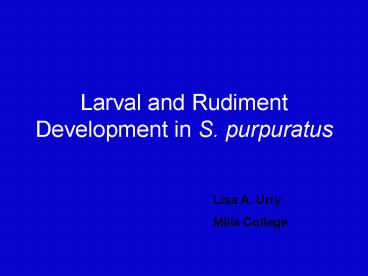Larval and Rudiment Development in S' purpuratus - PowerPoint PPT Presentation
1 / 24
Title: Larval and Rudiment Development in S' purpuratus
1
Larval and Rudiment Development in S. purpuratus
Lisa A. Urry Mills College
2
Pluteus
Juvenile
Stages I through VI
3
Stages of Larval Development
III Vestibular invagination
I Four Arm
II Eight Arm
III Rudiment initiation
V Pentagonal Disc
VI Advanced Rudiment
4
lpo
lpo
rpo
la
ra
la
A
A
R
An
Ab
L
P
Stage I Four Arm
- The anterolateral (la and ra) and postoral (lpo
and rpo) arms partially extend. - The coeloms partially extend along the gut.
- Feeding begins.
- The hydropore has already formed.
5
left coelom
rpo
lpo
la
ra
right coelom
6
Stage II Eight Arm
rpo
lpo
lpo
rpo
la
ra
lpd
rpd
oh
lpd
rpd
oh
ac
da
- The triradiate primordia of the spicules of the
posterodorsal (lpd and rpd) arms and dorsal arch
(da) appear. - The tissues of the oral hood (oh) and anal cup
(ac) become more elaborate. - The left coelom differentiates into the axocoel,
stone canal, hydrocoel, and somatocoel. - The right coelom differentiates into the axocoel,
hydrocoel and somatocoel.
7
ra
rpd
rh
lax
sc
lh
ls
- Left coelom axocoel (lax), stone canal (sc),
hydrocoel (lh), and somatocoel (ls).
- Right coelom axocoel (rax), hydrocoel (rh),
and somatocoel (rs).
8
Stage III Vestibular Invagination
rpo
lpo
la
ra
rpr
lpr
rpd
lpd
aep
vi
da
aep
pep
pep
ptr
- Left oral ectoderm invaginates (vi) to form the
vestibule. - The left and right somatocoels extend posteriorly
and laterally around the stomach. - The triradiate of the posterior transverse rod
(ptr)appears. - Preoral (lpr,rpr) arms lengthen, supported by the
dorsal arch. - Anterior and posterior epaulettes (aep,pep) begin
to form. - The indentation between the posterodorsal arms
and the postoral arms lengthens.
9
(No Transcript)
10
(No Transcript)
11
rs
aep
vi
pep
vi
lh
lh
ls
Abanal view
Anal view
III. Vestibular Invagination Stage
12
Stage IV Rudiment Initiation
lpo
rpo
vf
lh
lh
rs
vf
ap
ls
- Vestibule and left hydrocoel become apposed.
- The vestibular floor (vf) thickens.
- The anterior portion of the left somatocoel
becomes juxtaposed between the stomach and the
hydrocoel. - The left and right somatocoels meet at the
posterior end of the stomach. - Adult plates (ap) begin to form on the posterior
ends of the posterodorsal spicules and on the
body rods.
13
lh
vw
vf
ls
ls
ls
A
- The vestibular floor (vf) is thicker than the
wall (vw). - The anterior portion of the left somatocoel
becomes juxtaposed between the stomach and the
hydrocoel.
14
ra
la
rpd
lpd
aep
aep
vf
lh
rs
pep
pep
15
Stage V Pentagonal Disc
la
ra
rpo
lpo
lpr
vi
tf
lpd
rpd
vf
tf
lh
tf
ap
- The five tube feet (tf) originate as projections
of the hydrocoel against the vestibular floor
which grow outward and upward. - The left somatocoel projects against the
vestibular floor between the tube foot extensions
to form the dental sacs (ds). - The anterior and posterior epaulettes reach their
fullest extension.
16
ra
la
lpo
rpo
vf
vc
tf
tf
tf
ls
Abanal view
Stage V Pentagonal Disc (early)
- Tube feet are forming
- Vestibular opening remains narrow
tf
Anal view
17
vp
vc
View from left
Stage V Pentagonal Disc (late)
- Tube feet elongate as bilayered canals.
- Vestibule remains open to outside via a narrow
vestibular canal (vc)and pore (vp).
Abanal view
18
Stage VI Advanced Rudiment
tfs
sp
ep
tfs
js
Serial section through mid-rudiment
js
- The vestibular floor appears multi-layered (ep).
- Adult plates begin to form in the rudiment.
- Adult spines (sp) are present in the rudiment.
- Adult plates form at the dorsal arch and on the
right anterolateral spicule. - Structures with calcareous rings (tfs)are seen at
the distal ends of the tube-feet. - Five juvenile spines (js)form two at the
posterior apex and three on the right side of the
larva. - Pigment cells cluster around the rudiment,
posterior apex and near adult spines.
19
tf
ds
sp
tfs
sp
sp
ap
tf
Serial section from left larval side
Stage VI Advanced Rudiment
- Adult plates (ap)begin to form in the rudiment.
- Adult spines (sp) are present in the rudiment.
- Structures with calcareous rings (tfs)are seen
at the distal ends of the tube-feet. - A dental sac (ds) flanked by two spines is
present between each two tube-feet.
20
tf
Stage VI Advanced Rudiment
- A dental sac (ds) flanked by two spines is
present between each two tube-feet. - The bilayered tube-feet have extended outward,
forming primary radial canals. - An opening exists in the center of the hydrocoel,
defining the center of the ring canal.
ds
21
Stage VI Advanced Rudiment (late)
- The rudiment (rud) occupies most of the
blastocoelar space. - Tube feet may protrude through the vestibular
opening. - Larval arms appear shorter and may bend away
from the larval body. - Metamorphosis may occur.
22
(No Transcript)
23
Andy Cameron (Caltech)
Meighan Smith Luisa Smith (Mills College)
Brian Rowning (Lawrence Berkeley National Lab)
Simona Carini Lisa Labrecque
Fred Wilt Pat Hamilton (U.C.Berkeley)
24
(No Transcript)































